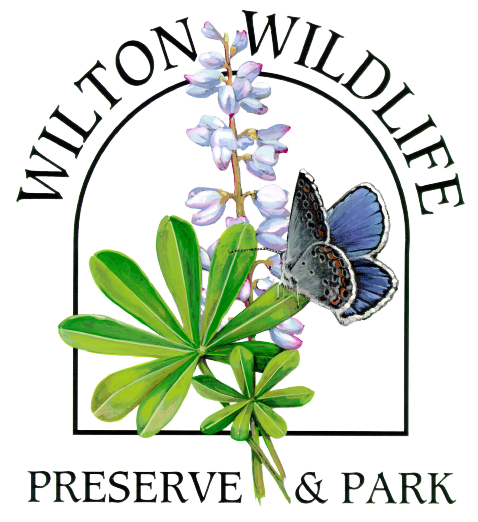Blanding’s Turtle: Threatened
Found nesting in newly created butterfly habitat in 2003, the Preserve & Park is one of only three locations it can be found in New York State, where is is listed as threatened.
Photo credit: Ryan Von Linden
Description
The Blanding's turtle has an average shell length of 7-9 inches and is considered medium-sized. They are easily identifiable because of their characteristic yellow chin and throat. The turtle's head and limbs are dark and speckled with yellow. Their carapace, or domed upper-shell, is also dark with yellow flecks. The under-shell, the plastron, is yellow with symmetrical dark markings. The turtle also looks as though it's smiling due to its upward curved beak. Like many turtles, the Blanding's turtle is omnivorous. Living close to the water provides them with food such as crustaceans, plants, and fish.
History and Status
The Blanding's turtle was first found at Wilton Wildlife Preserve & Park in 2003; interestingly, the nearest population is 100 miles away from the Park. Their range has traditionally centered around the Great Lakes from central Nebraska to southern Ontario, Canada and over to the southern shores of Lake Erie. Today, there are only isolated populations scattered across New York, New England, and Nova Scotia. The Blanding's turtle is considered a threatened species in the state of New York.
Life Cycle
The Blanding's turtle takes 14-20 years to reach sexual maturity, making it the slowest maturing vertebrate in North America. Mating begins in April and lasts until early May. The females will then travel to nest in sandy areas during the month of June. The average clutch size per female in New York State is 8 eggs, These hatchlings emerge between August and October. The Blanding's turtle can live for up to 80 years.
Habitat
Emergent wetlands with shallow water or vernal pools are the most popular spots for Blanding's turtles to reside, and are important for their survival. They overwinter, or brumate, in water, mud, or vegetation to prevent freezing in winter temperatures. Blanding's turtles can also travel fairly far upland. During nesting seasons, female turtles can be found in dry, sandy areas over half a mile from where they spend their winter. There are recorded incidents of the Blanding’s turtle nesting in Karner blue butterfly habitat restoration areas.
Why are they threatened?
Habitat loss is one of several reasons causing the decline of Blanding's turtle populations. The nesting and wetland habitats that the turtles live in are being destroyed for housing development and other commercial buildings. Nest predation is also a a threat to the turtles; skunks and raccoons are known to dig up nests. Another major cause of declining population sizes is the the loss of Blanding's turtles, particularly females, due to vehicle collisions. Often, there are roads that cross the turtle's brumation migration paths from wetlands to ponds as well as their nesting migration paths. The loss of a female Blanding's turtle due to collisions can significantly reduce the overall population as it decreases reproduction rates.
What is being done?
The New York State Department of Environmental Conservation and their partner organizations are conducting field surveys in order to define the Blanding's turtles' range in New York and to have better estimates of population sizes and trends in these groups. There is also an effort to mark and recapture turtles to define their daily and seasonal movements, habitat use, and areas of nest selection. In response to nest predators, there has been a push to find targeted nesting sites and protect those nests from skunks and raccoons.
What can you do?
If you see a Blanding's turtle, don't touch it or get too close. Instead, take a picture and report it to Wilton Wildlife Preserve & Park so we can get the information to the proper people at NYS DEC. The exception to this is if the turtle is crossing a road, in which case, carry it across the road in the direction that it was headed.
To access more information:
Download our Blanding's Turtle brochure here.
Para español, haga clic aquí.



